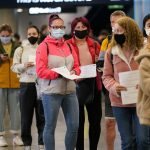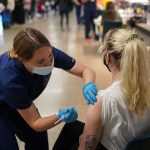The number of top A-level grades has surged for the second year running after external exams were scrapped in favour of teacher assessments during the pandemic.
Since 2019, the proportion of grades at B or less has dropped, with almost 45% of exams marked at A* or A in 2021, compared with just a third in 2019.
In Scotland, there has been a parallel increase in top grades in the Higher National Qualification.
John Nield, a former chief examiner at AQA, says it is concerning that results are improving despite a year of disrupted learning.
“Young people are being belittled and degraded by kidding them that approaching 50% of A-level students are worthy of an A* or A,” he said. “It’s about time somebody started to think about the long-term effects of the present situation.”
Despite the improvement in results, another key concern is the growing inequality between students.
The regional divide
Data shows a worsening regional divide between students in London and elsewhere. The capital already produced the highest proportion of A* and A results in 2019 and saw the largest increase over the last two years.
Meanwhile, the North East experienced the smallest increase in the top grades over this period, despite starting with the poorest results.
The institutional divide
There was also widening inequality between students at different types of schools, with private schools benefiting the most from the grade inflation.
More than two-thirds of grades awarded were top marks, compared with fewer than four in 10 at secondary comprehensive schools.
While the exam system alone cannot address all these inequities, this year’s results are still “concerning”, said shadow education secretary Kate Green.
She told Sky News: “There are some inequalities that have unfortunately been baked in and exacerbated in the results that we got today.”
The demographic divide
Historically disadvantaged students are also falling behind.
A third of students from “very high” deprivation backgrounds netted grades at A or higher, compared with almost half of students with a background classed as “very low” deprivation.
The chart below shows the growing percentage point gap in top grades between disadvantaged students and those who are not from the same ethnic and economic backgrounds.
Mr Nield said: “[It] just points to the increasing gap in provision linked to economic background. Those students without sharp-elbowed parents and without stable education will always come off worse.”
The gender divide
And while the number of A* and A grades in the core subjects has soared, there is a widening gap between male and female students.
Over the past two years, girls have started to outperform boys in mathematics, and the difference between A* and A grades awarded in English language has almost tripled.
So, while all children have lost out on learning due to COVID-19, it is the students that already lagged behind that struggled the most.
The Data and Forensics team is a multi-skilled unit dedicated to providing transparent journalism from Sky News. We gather, analyse and visualise data to tell data-driven stories. We combine traditional reporting skills with advanced analysis of satellite images, social media and other open source information. Through multimedia storytelling we aim to better explain the world while also showing how our journalism is done.






















